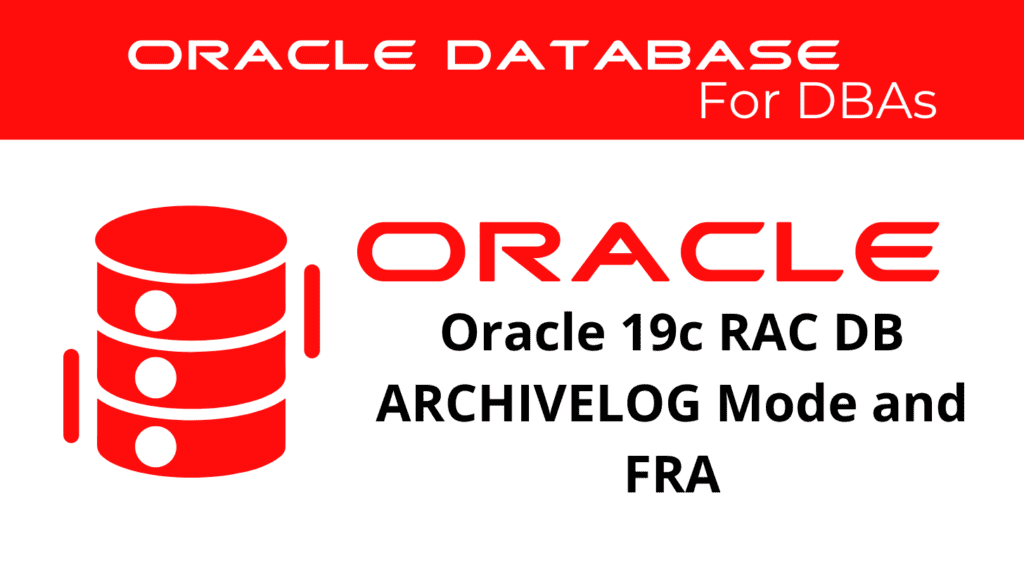
Configuring the Oracle 19c RAC database to use ARCHIVELOG mode and the fast recovery area is crucial for ensuring data availability and recoverability. RAC ARCHIVELOG Mode enables continuous archiving of redo logs, while the RAC Fast Recovery Area provides a centralized storage location for backups and archived logs. In this blog, we will discuss the steps to configure these features, the importance of each, and best practices to follow.
Configuring RAC ARCHIVELOG Mode
RAC ARCHIVELOG Mode is essential for enabling the continuous archiving of redo logs, which ensures that all changes made to the database are recorded and can be recovered in the event of a failure.
Enabling ARCHIVELOG Mode
To enable ARCHIVELOG mode, the database must be mounted but not open. This requires restarting the database instances.
-- Shutting down the database
srvctl stop database -d RACDB
-- Starting the database in mount mode
srvctl start database -d RACDB -o mount
-- Enabling ARCHIVELOG mode
sqlplus / as sysdba
ALTER DATABASE ARCHIVELOG;
-- Opening the database
ALTER DATABASE OPEN;
Verifying ARCHIVELOG Mode
After enabling ARCHIVELOG mode, verify the configuration to ensure it is active.
-- Checking ARCHIVELOG mode
ARCHIVE LOG LIST;
Setting Up Fast Recovery Area in RAC
The RAC Fast Recovery Area is a unified storage location for all recovery-related files, such as backups, archived logs, and flashback logs. Setting up this area improves the manageability and performance of backup and recovery operations.
Configuring the Fast Recovery Area
To configure the fast recovery area, set the appropriate parameters in the database.
-- Setting the Fast Recovery Area location and size
ALTER SYSTEM SET db_recovery_file_dest = '+FRA' SCOPE=BOTH SID='*';
ALTER SYSTEM SET db_recovery_file_dest_size = 100G SCOPE=BOTH SID='*';
Verifying Fast Recovery Area Setup
Verify that the fast recovery area is configured correctly and accessible from all instances.
-- Checking the Fast Recovery Area configuration
SHOW PARAMETER db_recovery_file_dest;
SHOW PARAMETER db_recovery_file_dest_size;
📢 You might also like: Oracle 19c RMAN for the RAC Environment (Category: RAC and GRID)
Best Practices for ARCHIVELOG and Recovery Area Configuration
Implementing best practices ensures the optimal performance and reliability of the RAC database.
Regularly Monitoring the Fast Recovery Area
Monitor the usage of the fast recovery area to prevent it from becoming full, which could interrupt database operations.
-- Checking the Fast Recovery Area usage
SELECT * FROM V$RECOVERY_AREA_USAGE;
RAC ARCHIVELOG Mode – Configuring Redundancy and Retention Policies
Set appropriate redundancy and retention policies to manage the space usage in the fast recovery area effectively.
-- Configuring retention policy
RMAN> CONFIGURE RETENTION POLICY TO REDUNDANCY 2;
-- Configuring backup optimization
RMAN> CONFIGURE BACKUP OPTIMIZATION ON;
Ensuring Instance Access
Ensure that all RAC instances have access to the fast recovery area and the archive log destinations.
-- Verifying instance access to the fast recovery area
HOST ls -l /u01/app/oracle/fast_recovery_area;
-- Verifying instance access to archive log destinations
ARCHIVE LOG LIST;
Troubleshooting Configuration Issues
Even with proper planning, issues can arise during configuration. Here are common problems and their solutions.
Resolving RAC ARCHIVELOG Mode Issues
Issues with enabling ARCHIVELOG mode often stem from improper shutdown or mount commands.
-- Resolving ARCHIVELOG mode issues
ALTER DATABASE ARCHIVELOG;
ALTER DATABASE OPEN;
Addressing Fast Recovery Area Problems
Problems with the fast recovery area can include insufficient space or misconfigured parameters.
-- Resolving Fast Recovery Area issues
ALTER SYSTEM SET db_recovery_file_dest_size = 200G SCOPE=BOTH SID='*';
-- Cleaning up obsolete backups
RMAN> DELETE OBSOLETE;
See more on Oracle’s website!
Conclusion
In conclusion, configuring Oracle 19c RAC database to use ARCHIVELOG mode and the fast recovery area is critical for data protection and recovery. By following best practices and ensuring proper setup, you can enhance the reliability and performance of your RAC environment. Regular monitoring and proactive management of these configurations will help maintain a robust and resilient database system.
Be Oracle RAC and GRID Certified Professional, this world is full of opportunities for qualified DBAs!





